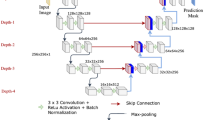Abstract
Purpose
Ultrasound image segmentation is a crucial step in computer-aided diagnosis. In this study, we propose a cross-tissue/organ segmentation method based on the transfer learning method and a modified deep residual U-Net model.
Methods
We present a modified deep residual U-Net model by integrating a U-Net architecture with residual blocks to leverage the advantages of both components. Next, we explore a cross-tissue/organ transfer learning method for ultrasound image segmentation, which transfers the knowledge of ultrasound image segmentation from one tissue/organ to another, e.g. from tendon images to breast tumor images and vice versa. We evaluated the proposed method by performing four groups of experiments on three medical ultrasound datasets, consisting of one tendon dataset and two breast datasets, along with one non-medical dataset.
Results
The results showed an overall performance improvement by our method in terms of the Dice coefficient and Jaccard index. It was demonstrated that our modified deep residual U-Net exceeded the standard U-Net and residual U-Net, and the cross-tissue/organ transfer learning was superior to training from scratch and to transfer learning between divergent domains.
Conclusion
Our method shows potential to accurately segment medical ultrasound images.




Similar content being viewed by others
References
Huang, Q., & Zeng, Z. (2017). A review on real-time 3D ultrasound imaging technology. Biomedical Research International, 2017, 6027029.
Song, Y., et al. (2015). Accurate segmentation of cervical cytoplasm and nuclei based on multiscale convolutional network and graph partitioning. IEEE Transactions on Biomedical Engineering, 62(10), 2421–2433.
Huang, Q., Luo, Y., & Zhang, Q. (2017). Breast ultrasound image segmentation: A survey. International Journal of Computer Assisted Radiology and Surgery, 12(3), 493–507.
Huang, Q., Zhang, F., & Li, X. (2018). Machine learning in ultrasound computer-aided diagnostic systems: A survey. Biomedical Research International, 2018, 5137904.
Shen, D., Wu, G., & Suk, H. I. (2017). Deep learning in medical image analysis. Annual Review of Biomedical Engineering, 19, 221–248.
Ronneberger, O., Fischer, P., & Brox, T. (2015). U-Net: Convolutional networks for biomedical image segmentation. In Medical image computing and computer-assisted intervention—MICCAI 2015 (pp. 234–241).
Yu, Z., et al. (2018). A deep convolutional neural network-based framework for automatic fetal facial standard plane recognition. IEEE Journal of Biomedical and Health Informatics, 22(3), 874–885.
He, K., et al. (2016). Deep residual learning for image recognition. In 2016 IEEE conference on computer vision and pattern recognition (CVPR), 2016 (pp. 770–778).
Zhang, Z., Liu, Q., & Wang, Y. (2018). Road extraction by deep residual U-Net. IEEE Geoscience and Remote Sensing Letters, 15(5), 749–753.
Tajbakhsh, N., et al. (2016). Convolutional neural networks for medical image analysis: Full training or fine tuning? IEEE Transactions on Medical Imaging, 35(5), 1299–1312.
Shin, H. C., et al. (2016). Deep convolutional neural networks for computer-aided detection: CNN architectures, dataset characteristics and transfer learning. IEEE Transactions on Medical Imaging, 35(5), 1285–1298.
Byra, M., et al. (2019). Breast mass classification in sonography with transfer learning using a deep convolutional neural network and color conversion. Medical Physics, 46(2), 746–755.
Lin, Z., et al. (2019). Multi-task learning for quality assessment of fetal head ultrasound images. Medical Image Analysis, 58, 101548.
Lei, B., et al. (2015). Automatic recognition of fetal facial standard plane in ultrasound image via Fisher vector. PLoS ONE. https://doi.org/10.1371/journal.pone.0121838.
Xian, M., et al. (2018). Automatic breast ultrasound image segmentation: A survey. Pattern Recognition, 79, 340–355.
Milletari, F., Navab, N., & Ahmadi, S.-A. (2016). V-Net: Fully convolutional neural networks for volumetric medical image segmentation. In 2016 Fourth international conference on 3D vision (3DV), 2016 (pp. 565–571).
Kingma, D. P., & Ba, J. (2015) Adam: A method for stochastic optimization. CoRR. abs/1412.6960.
Dong, H., et al. (2017). Automatic brain tumor detection and segmentation using U-Net based fully convolutional networks. In Medical image understanding and analysis. MIUA 2017. Communications in computer and information science (pp. 506–517). Cham: Springer.
Yap, M. H., et al. (2018). Automated breast ultrasound lesions detection using convolutional neural networks. IEEE Journal of Biomedical and Health Informatics, 22(4), 1218–1226.
Piotrzkowska-Wroblewska, H., et al. (2017). Open access database of raw ultrasonic signals acquired from malignant and benign breast lesions. Medical Physics, 44(11), 6105–6109.
Kahala, G., Sklair, M., & Spitzer, H. (2018). Multi-scale blood vessel detection and segmentation in breast MRIs. Journal of Medical and Biological Engineering, 39(3), 424–430.
Du, Y.-M., et al. (2018). Development of a dual-energy computed tomography-based segmentation method for collateral ligaments: A porcine knee model. Journal of Medical and Biological Engineering, 39(1), 96–101.
Acknowledgements
This work was supported by the National Natural Science Foundation of China (Grant Numbers 61911530249, 62071285 and 61671281).
Author information
Authors and Affiliations
Corresponding authors
Rights and permissions
About this article
Cite this article
Huang, H., Chen, H., Xu, H. et al. Cross-Tissue/Organ Transfer Learning for the Segmentation of Ultrasound Images Using Deep Residual U-Net. J. Med. Biol. Eng. 41, 137–145 (2021). https://doi.org/10.1007/s40846-020-00585-w
Received:
Accepted:
Published:
Issue Date:
DOI: https://doi.org/10.1007/s40846-020-00585-w




